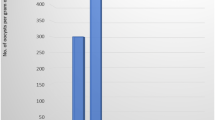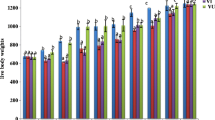Abstract
The consequence of cryptosporidiosis on the immune response of vaccinated chickens against Newcastle disease and/or avian influenza was studied by using 240, 1 day old, male, white Hy-Line chicks and divided into 8 groups and subgroups. Each group or subgroup was consisting of 30 chicks (15 × 2 replicates). The first and second groups were kept as unvaccinated control, G1uninfected and G2 infected. G3, G4 and G5 contained 2 subgroups A&B (G3A, G3B, G4A, G4B, G5A and G5B). Chicks of subgroup A were vaccinated only while chicks of subgroup B were infected and vaccinated. These chicks were orally inoculated with 5 × 105 oocysts of Cryptosporidium baileyi (C. baileyi) at 2 days of age. Chickens were vaccinated intraocular with live Newcastle disease (ND) vaccine (Hitchner on day 7th and LaSota on day 17th of chicken life) (G3) or vaccinated by subcutaneous route with Volvac®- H5N2- AI vaccine on day 10 of chicken life (G4). Last group (G5) was infected similarly and vaccinated with ND and AI vaccines with the same day, dose and route of vaccination for each one. Random blood samples were collected for 3 weeks post-vaccination for investigation of humoral immune response against Newcastle and/or avian influenza vaccines by the haemagglutination inhibition (HI) test. The results showed that H5N2 vaccine at day 10 of chicken life is effective in chickens indicated by the geometric mean of HI titer against AI virus. The findings of this study showed that the infection with Cryptosporidia in the broiler chicken has a depressive effect on the immune status of the birds vaccinated against ND and/or AI vaccination. Moreover, the obtained protection rates against challenge with virulent ND virus observed to be parallel to the results of HI- test. Also, by using 2 different antigens (one commercial and field prepared antigen) to avian influenza virus, lower Geometric mean (GM) HI titer were appeared in infected and vaccinated group than vaccinated group only. A study of the relative lymphoid organs weight such as bursa of Fabricius from the experimental chicks indicated that those organs were comparable between the groups infected-vaccinated and vaccinated only. Non significant variations in final live weight between uninfected control and infected groups were indicated. Also, H5N2-AI vaccination at 10 days old did not affect the final live weight. ND and/or AI Vaccination could not be a substitute to application of good hygienic measures and fecal examination of the birds especially for protozoal diseases such as cryptosporidiosis. It could be concluded that cryptosporidiosis could be one cause of ND and/or AI vaccination failure in poultry farms.




Similar content being viewed by others
References
Abd Elwanis NA, Amin AH, Madkour MS, Khashabah EM (1997) Effect of the infection with Cryptosporidium on the immune response of chickens vaccinated with Newcastle disease vaccines and/or Gumboro disease vaccines. Assiut Vet Med J 38 (75)
Alexander DJ (1991) Newcastle disease and other paramyxoviridae infections In: Disease of poultry 9th. In: Calnek BW, Barnes HJ, Beard CW, Reid WM, and Yoder HW (eds) Iowa State University press, Ames, Iowa. 506–519
Anon (1971) Methods for examining poultry biologics and for identifying and quantifying avian pathogens. Nat. Acad. Sci, Washington, pp 270–279
Banai M, Pourbakhsh SA, Ezzi A, Ardehali M, Jannati M (2002) Coinfection Associated with Naturally Occurring Cryptosporidiosis in Broilers. Arch Razi Ins (53)
Beard CW (1989) Serologic procedures, in A laboratory manual for the isolation and identification of avian pathogens, 3rd edn.In: Purchase HG, Arab LH, Domerumuth CH, Pearson JE (eds). American Association of avian Pathologist, Kennett square, 192–200
Blagburn BL, Lindsay DS, Giambrone JJ, Sundermann CA, Hoerr FJ (1987) Experimental cryptosporidiosis in broiler chickens. Poult Sci 66:442–449
Blagburn BL, Lindsay DS, Hoerr FJ, Davis JF, Giambrone JJ (1991) Pathobiology of cryptosporidiosis (C. baileyi) in broiler chickens. J Protozool 38(6):258–275
Current WL, Long PL (1983) Development of human and calf Cryptosporidium in chicken embryos. J Infect Dis 148(6):1108–1113
Doubney R, Mansi W (1947) The occurrence of ND in Egypt. J Comp Path 28:189–200
Doyle TM (1927) Newcastle disease of fowls .Cited by Doyle TM (1935). J Comp Pathol Therap 48:1–20
Eladl AH, Abou El-Azm KI, Ismail AE, Ali A, Saif YM, Lee CW (2011) Genetic characterization of highly pathogenic H5N1 avian influenza viruses isolated from poultry farms in Egypt. Virus Genes 43:272–280
El-Sayed DA, Abdou AM, Shalash SM, Safaa HM, Riad SA (2011) Productivity and immune response of broiler chickens vaccinated with different avian influenza vaccines at 1 or 7 days of age. Aust J Basic Appl Sci 5(10):325–334
Faragher JT, Allan WH, Wyeth PJ (1974) Immunosuppressive effect of infectious bursal agent on vaccination against Newcastle disease. Vet Rec 95:385–388
Hamed RH Ahmed (1992) Some studies on Cryptosporidia (coccidia) of chickens. M.V.Sc. Thesis, Department of Parasitology, Faculty of Veterinary Medicine, Zagazig University
Hamed RH Ahmed (1997) Further study on Cryptosporidia in poultry. Ph.D. Thesis, Department of Parasitology, Faculty of Veterinary Medicine, Zagazig University
Hao YX, Yang JM, He C, Liu Q, McAllister TA (2008) Reduced serologic response to avian influenza vaccine in specific-pathogen-free chicks inoculated with Cryptosporidium baileyi. Avian Dis 52(4):690–693
Kaoud HA, Zakia MA, Kamel MM (2008) Evaluation of the immune response in ai vaccinated broiler chickens: effect of biosecurity faults on immune response. Int J Poult Sci 7(4):390–396
Lindsay DS, Blagburn BL, Sundermann CA, Hoerr FJ, Ernest JA (1986) Experimental cryptosporidium infection in chickens; oocysts structure and tissue specificity. Am J Vet Res 47:876–879
Lindsay DS, Blagburn BL, Sundermann CA, Ernest JA (1987) Chemoprophylaxis of cryptosporidiosis in chickens, using halofuginone, salinomycin, lasalocid, or monensin. Am J Vet Res 48:354–355
Mazariegos LA, Lukert PD, John B (1990) Pathogenicity and immunosuppressive properities of infectious bursal disease “intermediate” stains. Avian Dis 34:203–208
Nassef AS (1996) The effect of cryptosporidiosis on the immune response against different Newcastle disease vaccines. Thesis M.V.Sc., Fac.Vet. Med., Cairo Univ
Pejkovski C, Davelaar FG, Kouwenhoven B (1979) Immunosuppressive effect of infectious bursal disease virus on vaccination against infectious bronchitis. Avian Pathol 8(1):95–106
Reed LJ, Muench H (1938) Simple method of estimating 50 percent end point. Amer J Hyg 27:493–499
Rhee JK, Seu YS, Park BK (1991) Isolation and identification of Cryptosporidium from various animals in Korea 1. Prevalence of Cryptosporidium in various animals. Korean J Parasitol 29(2):139–148
Rhee JK, Kim HC, Park BK (1997) Effects of Cryptosporidium baileyi infection on the bursa of Fabricius in chickens. Korean J Parasitol 3:181–187
Rhee JR, Hyeon CK, Sang BL, Sim YY (1998a) Immunosuppressive effect of Cryptosporidium baiylei infection on vaccination against Newcastle disease in chicks. Korean J Parasitol 36(2):121–125
Rhee JK, Yang HJ, Yook SY, Kim HC (1998b) Immunosuppressive effect of Cryptosporidium baileyi infection on vaccination against avian infectious bronchitis in chicks. Korean J Parasitol 36(3):203–206
Risa I Dharmayanti I (2012) Antibody level of Avian influenza of subtypesH5 in commercial broiler farms. International Conference on Livestock Production and Veterinary Technology
Saeed Z, Ahmad S, Rizvi AR, Ajmal M (1988) Role of maternal antibody in determination of an effective Newcastle disease vaccination programme. Pak J Vet Res 1:18–21
Samir AN (1996) The effect of Cryptosporidiosis on the immune response against different Newcastle disease vaccines. M.V.Sc. Thesis, Department of Poultry and rabbit diseases, Faculty of Vet. Med. Cairo Univ
Sheble A, Reda IM (1976) Cited by Khafagy A.K., (1977) Thesis M.V.Sci, Fac. Vet. Med., Cairo Univ
Snedecor GW, Cochran WG (1981) Statistical methods, 7th edn. Iowa State University, Ames
Sréter T, Varga I (2000) (2000) Cryptosporidiosis in birds — a review. Vet Parasitol 87:261–279
Tanimura N, Tsukamoto K, Nakamura K, Narita M, Maeda M (1995) Association between pathologenicity of Infectious bursal disease virus and viral antigen distribution detected by immunochemistry. Avian Dis 39:9–20
Tumova E, Skrivan M, Marounek M, Pavlasek I, Ledvinka Z (2002) Performance and Oocyst shedding in broiler chickens orally infected with Cryptosporidium baileyi and Cryptosporidium meleagridis. Avian Dis 46:203–207
Tyzzer EE (1929) Coccidiosis in gallinaceous birds. Am J Hyg 10, 269–383. Cited by Sréter T and Varga I (2000) Cryptosporidiosis in birds — A review. Vet. Parasitol 87 (2000) 261–279
Villegase P, Purchase HG (1989) Calculation of geometric mean titers, in a laboratory manual for the isolation and identification of avian pathogens. In: Purchase HG, Arab LH, Domerumuth CH, Pearson JE (eds) American Association of avian Pathologists, Kennett. Square, PA, 121–123
Conflict of interest
The authors declare that they have no conflict of interest.
Author information
Authors and Affiliations
Corresponding author
Rights and permissions
About this article
Cite this article
Eladl, A.H., Hamed, H.R. & Khalil, M.R. Consequence of Cryptosporidiosis on the immune response of vaccinated broiler chickens against Newcastle disease and/or avian influenza. Vet Res Commun 38, 237–247 (2014). https://doi.org/10.1007/s11259-014-9610-5
Accepted:
Published:
Issue Date:
DOI: https://doi.org/10.1007/s11259-014-9610-5




